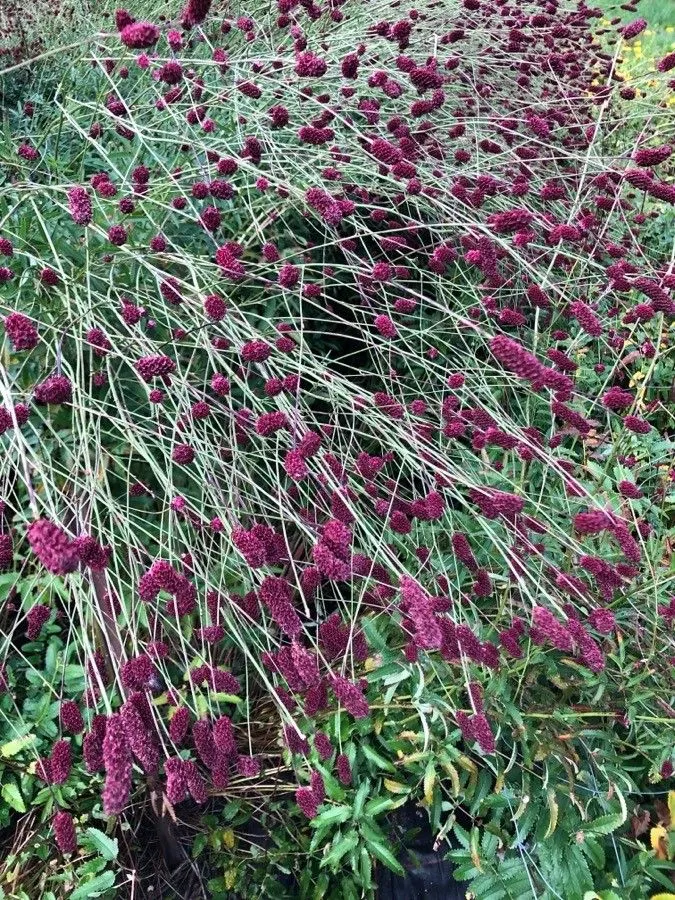
Author: L.
Bibliography: Sp. Pl.: 116 (1753)
Year: 1753
Status: accepted
Rank: species
Genus: Sanguisorba
Vegetable: False
Observations: Temp. Northern Hemisphere
Burnet bloodwort, known by its scientific name Sanguisorba officinalis, is a well-regarded perennial plant indigenous to the temperate zones of the Northern Hemisphere. First described in 1753 in the authoritative botanical reference “Species Plantarum” by the renowned botanist Carl Linnaeus, this plant proudly belongs to the Rosaceae family, distinguishing itself with its unique botanical features.
Characterized by its tall, slender stature with pinnate leaves and an enduring flowering presence, the burnet bloodwort exhibits small, deep-red to purple, densely packed flowers arranged in compact cylindrical spikes. These blossoms emerge in late summer to early autumn, adding a touch of vibrant yet subtle beauty to natural landscapes and gardens.
Adapted to thrive in a variety of environments, Sanguisorba officinalis often finds its home in meadows, grasslands, and riverbanks. It is a robust and versatile species, demonstrating resilience in both moist and well-drained soils. The plant’s deep roots help it withstand periodic floods as well as dry spells, contributing to its hardiness and ease of cultivation in temperate climates.
Burnet bloodwort has not only aesthetic value but also holds intrigue for herbal enthusiasts and modern practitioners of traditional medicine. Historically, the plant has been utilized for its astringent properties, believed to aid in treating gastrointestinal issues and to staunch bleeding. Its leaves, sometimes consumed fresh or dried, are noted for their slightly bitter, cucumber-like flavor and are a unique addition to culinary dishes.
Despite its rich history and diverse applications, Sanguisorba officinalis remains a uniquely charming yet understated component of the broader Rosaceae family. Whether enriching meadows or enhancing garden spaces, the burnet bloodwort continues to capture the interest and admiration of botanists, herbalists, and gardeners alike.
Understanding and appreciating the detailed taxonomy, ecological preferences, and traditional uses of burnet bloodwort underscores the plant’s importance in natural and cultivated ecosystems. As a lasting testament to the botanical curiosity of Linnaeus and generations of plant enthusiasts, Sanguisorba officinalis remains a species well worth exploring.
Eng: burnet bloodwort, great burnet, official burnet, salad burnet, sanguisorba
Deu: großer wiesenknopf
Dan: læge-kvæsurt
Lav: arstniecibas brunvalite
Swe: blodtopp, punaluppio
Nob: blodtopp
Nno: blodtopp
Fra: grande pimprenelle, sanguisorbe, sanguisorbe officinale, pimprenelle officinale
Nld: grote pimpernel
Spa: pimpinela mayor
Fin: punaluppio
Nor: rød pimpernelle
Cym: bwrned mawr, clust yr arth, deilen dda, golcheuraid, golcheuraid y coed, golchwraidd, golchyddes, gwengraith, olch-euraidd
En: Burnet bloodwort, Salad burnet, Great burnet, Sanguisorba, Official burnet, Common Burnet, Garden Burnet, Greater Burnet
Ar: مرقئة مخزنية
Hy: Արյունախմիկ դեղագործական
Az: Dərman sincanotu
Ba: Ҡырҡҡолас
Eu: Gaitun sendagarri
Be: Крывасмок лекавы
Bg: Лечебна динка
Ca: Pimpinella major
Zh: Di yu, 地榆
Kw: Koghles
Cs: Krvavec toten
Da: Læge-Kvæsurt
Nl: Grote pimpernel
Et: Ürt-punanupp
Fi: Punaluppio
Fr: Grande pimprenelle, Sanguisorbe officinale, Sanguisorbe, Pimprenelle officinale
De: Großer Wiesenknopf
Hu: Őszi vérfű
Is: Blóðkollur
Ga: Lus an uille mór
It: Meloncello, Selvastrella maggiore, Salvastrella maggiore
Ko: 오이풀
Lv: Ārstniecības brūnvālīte, Arstniecibas brunvalite
Lt: Vaistinė kraujalakė
Mk: Голема изгореница
Mn: Сөд
No: Blodtopp, Rød pimpernelle
Nb: Blodtopp
Nn: Blodtopp
Os: Сырхкъоппагæрдæг
Fa: توت روباهی طبی
Pl: Krwiściąg lekarski
Pt: Pimpinela, Pimpinela-hortense, Pimpinela-menor (1)
Ru: Кровохлёбка лекарственная
Sk: Krvavec lekársky
Es: Pimpinela mayor, Sanguisorba, Zdravilna strašica, Pimpinela negra
Sv: Blodtopp, Punaluppio
Zh-tw: 地榆
Zh-hant: 地榆
Uk: Родовик лікарський
Cy: Bwrned Mawr, Clust yr Arth, Deilen Dda, Golcheuraid, Golcheuraid y Coed, Golchwraidd, Golchyddes, Gwengraith, Olch-Euraidd
Za: Maxlienzan
Taken Jul 19, 2018 by Denis Bastianelli (cc-by-sa)
Taken Jul 16, 2019 by Emilie Sauvage (cc-by-sa)
Taken Jul 29, 2017 by Heinz Gass (cc-by-sa)
Taken Jul 23, 2017 by Jean-Marie Frenoux (cc-by-sa)
Taken Aug 3, 2016 by Lilian Car (cc-by-sa)
Taken Aug 19, 2021 by Jacques Zuber (cc-by-sa)
Taken Jul 15, 2022 by Blue Bottle (cc-by-sa)
Taken Aug 16, 2020 by Sabaté Sant Jordi (cc-by-sa)
Taken Jul 20, 2021 by Terje Norli (cc-by-sa)
Taken Aug 10, 2021 by MF Paier (cc-by-sa)
Taken Jul 24, 2020 by Philippe Beerschneider (cc-by-sa)
Taken Aug 5, 2018 by Christophe Chabot (cc-by-sa)
Taken Sep 4, 2022 by Sabalotta Sabalotta Langstrumpf (cc-by-sa)
Taken Jul 29, 2011 by Tela Botanica − Yoan MARTIN (cc-by-sa)
Taken Jul 20, 2021 by Terje Norli (cc-by-sa)
Taken Oct 18, 2021 by Philippe Wyss (cc-by-sa)
Taken Jul 20, 2021 by Terje Norli (cc-by-sa)
Taken Jul 11, 2021 by Darren Giddins (cc-by-sa)
Taken Aug 16, 2020 by Sabaté Sant Jordi (cc-by-sa)
Taken Jul 21, 2019 by Cordula Scherl (cc-by-sa)
Taken Jul 26, 2019 by součková veronika (cc-by-sa)
Taken Jul 25, 2021 by Darren Giddins (cc-by-sa)
Taken Jul 11, 2021 by Darren Giddins (cc-by-sa)
Taken Aug 24, 2020 by lavendel (cc-by-sa)
Taken May 9, 2019 by Regne Concha (cc-by-sa)
Taken Jan 1, 1900 by EOL − Malcolm Storey (cc-by-nc-sa)
Taken Jun 26, 2015 by Tela Botanica − Ans GORTER (cc-by-sa)
Taken Aug 28, 2022 by Easger (cc-by-sa)
Taken Nov 3, 2016 by Yoan MARTIN (cc-by-sa)
Taken Jul 28, 2022 by Joachim Klaus (cc-by-sa)
© copyright of the Board of Trustees of the Royal Botanic Gardens, Kew.
© copyright of the Board of Trustees of the Royal Botanic Gardens, Kew.
© copyright of the Board of Trustees of the Royal Botanic Gardens, Kew.
Growth habit: Forb/herb
Ph maximum: 7.5
Ph minimum: 7.0
Light: 8
Atmospheric humidity: 7
Soil nutriments: 5
Family: Myrtaceae Author: (F.Muell.) K.D.Hill & L.A.S.Johnson Bibliography: Telopea 6: 402 (1995) Year: 1995 Status:…
Family: Rubiaceae Author: Pierre ex A.Froehner Bibliography: Notizbl. Bot. Gart. Berlin-Dahlem 1: 237 (1897) Year:…
Family: Sapindaceae Author: Koidz. Bibliography: J. Coll. Sci. Imp. Univ. Tokyo 32(1): 38 (1911) Year:…
Family: Asteraceae Author: A.Gray Bibliography: Pacif. Railr. Rep.: 107 (1857) Year: 1857 Status: accepted Rank:…
Family: Fabaceae Author: Medik. Bibliography: Vorles. Churpfälz. Phys.-Ökon. Ges. 2: 398 (1787) Year: 1787 Status:…
Family: Aspleniaceae Author: (Cav.) Alston Bibliography: Bull. Misc. Inform. Kew 1932: 309 (1932) Year: 1932…